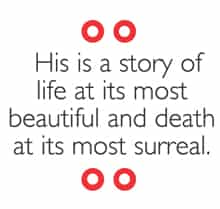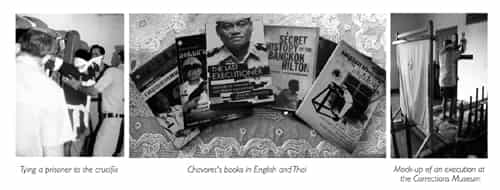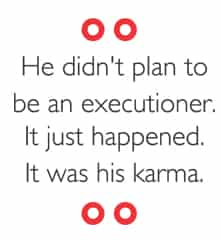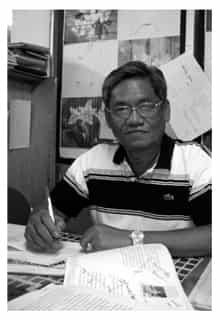Chavoret Jaruboon executed 55 people, including one woman; I am very sorry we never got to be closer friends.
Chavoret is better known as ‘The Last Executioner’, which is also the title of his 2006 autobiography in English. (The Thai version is ?.) He was the last person in Thailand whose job it was to carry out court-ordered executions by gun before the switchover to lethal injection, which is the method still used today.
For 33 years, Chavoret worked at Bang Kwang Prison (sensationalised as ‘The Bangkok Hilton’), and acted as resident executioner from 1984 to 2003, carrying out a total of 55 executions over 19 years. It wasn’t exactly like he arrived at work each day, punched the clock, and killed someone, although it certainly was an odd career.
I am currently writing a biographical screenplay about him which will go into production in early 2013, produced by DeWarrenne Pictures. His is a story of life at its most beautiful and death at its most surreal, and the experience of writing the film has been almost as bizarre as the story itself.
A Strange Introduction
I first met Chavoret in April 2007 when he was part of a panel discussion on prison life, following a recent publication of his book, at the Foreign Correspondents Club of Thailand (FCCT). The others on the panel were Susan Aldous, known as ‘The Angel of Bangkok’ for her work with slum children and prisoners at Bang Kwang, and the Thai owner of a travel agency arrested for money laundering. During the evening, my overwhelming impression of Chavoret was that he was so normal. Watching him sitting there in a polo shirt and Dockers – no black hood and scythe – he looked like anyone I might sit next to on the BTS or at Starbucks.
When it came time for the Q and A session, I was surprised at how softball the questions were. I ended up making my own inquiries, which went something like this: “You seem like a nice guy and all, but how did you reconcile your work with your Buddhism? What did you tell your family? Did you go out for beers with the guys after executions?” (It turns out he did.)
I now know that Chavoret had answered variants of these questions a thousand times before. His answers focused on karma. It was his karma to do this job, and he was compassionately helping the prisoners to achieve their own karma. It was his duty, after all. At the time, this all smacked of a well-devised construction of denial, or worse, an “I was just following orders” defence. I wanted to know more, so I introduced myself and asked for an interview, which his editor arranged.
A week later, I was in Chavoret’s office at Bang Kwang’s Foreign Affairs Division, which he now headed. Of course, I’d read the book by then, so I knew his background. Nevertheless, it was still very weird when, without any explanation, this 59-year-old executioner sat across his desk from me and for 30 minutes played air guitar and sang Beatles, Elvis, and Ventures songs. Then, we talked. And talked. We talked for almost 5 hours.
The Early Years
It turns out that in his late teens and early 20s, Chavoret was a wild rock and roller who jumped all over the stage, played guitar behind his back while his drummer hung from the ceiling, and once even smashed his guitar – kind of pre-Who. He was really cool, dressed in the tightest 60s pants and skinny ties, and moved, as the Thai expression used to describe Elvis, like “a worm burning in ash.” He and his band, Mitra, played the bars in Udon, Ubon and Bangkok, where the American GIs partied on R&R from the Vietnam War. His favourite bar was aptly named (for an executioner-to-be) ‘Sorry About That’.
During this time, he met his sweetheart, Tew, whom he married and stayed with for 43 years until his death earlier this year. When Tew announced she was pregnant, Chavoret, whose father was a teacher, decided he needed to do the ‘respectable’ thing and get a practical job so he could support a family. After leaving his first love (rock and roll) behind for his next love, he tried a succession of jobs – teacher, translator on an oil rig, paramedic – but none felt right. Then, a cousin told him of a civil service exam for prison guards. Chavoret liked the guaranteed work, pension, and education benefits for his kids, so he took the exam. He didn’t plan to be an executioner. It just happened. It was his karma.

Politically Incorrect
Throughout history, executions in Thailand have always been very choreographed, and often very cruel. If you go to the Corrections Museum in Bangkok, you can see paintings and dioramas of Thai torture and execution methods from the Ayutthaya Period (1350-1767) to the present. Among the 50 or so Ayutthaya Period tortures illustrated, my favourite (a strange word in this context) is when they cut off the flesh of a live prisoner, grilled it, and force-fed it to him. I won’t spoil the surprises of the other 49.
Beheadings were the legal execution method from 1903-1934, and these were pretty grisly, involving a second person whose job it was to dance in front of the prisoner and try to distract him while his head was hacked off and then placed on a stick for all to see. Another lovely method from this period _ up through the 1930s, mind you _ was locking the prisoner into a giant ball with spikes inside and getting an elephant to roll it around. Not so sabai sabai.
From 1934 on, executions were done by gun, until the switch to lethal injection in 2003.
Chain of Command
During Chavoret’s tenure at Bang Kwang, the process was – and still is – the epitome of choreographed division of labour. Chavoret started at the lowest job, and because he was such a responsible and precision-oriented worker, he rose through the ranks until he was offered the executioner’s job. It’s worth going through all the jobs to know the context in which he worked.
First is the pi liang, whose job it is to get the prisoner from death row. Prisoners in death row are still shackled by foot 23 hours a day. There was no advanced notice about executions, but when a pi liang came, everybody knew someone would be dead within a few hours. Next, an escort walked the prisoner, still in shackles, across the prison yard, which was full of prison personnel, doctors, government officials, and witnesses. Next stop was the octagonal ‘cool pavilion’ where the prisoner met with a monk and was photographed and fingerprinted for identification. A guard was assigned to give the prisoner a pencil and paper to write anything he wanted – a letter to his family or to the King, to Lord Buddha, or simply his last will and testament. The next job was to blindfold the prisoner, give him a lotus and some joss sticks, and walk him into the execution room under a sign which reads ‘The End of All Suffering’. (Later in life, Chavoret said it more correctly should have read ‘Death Chamber’.)

Wait. There’s more. The next job was to tie the prisoner to a standing wooden cross, so he would be facing a wall of sandbags with his back to the executioner. The prisoner was tied to this crucifix with his hands holding the lotus in front of him. The next guard positioned a standing wooden frame with a cloth screen between the prisoner and the executioner, and attached a small cardboard bullseye target on the screen corresponding to where the prisoner’s heart would be if shot from behind. Another would wheel in the gun, check the mechanism, load the cartridges, and aim it. Finally, the executioner would enter, wai and ask forgiveness of the soon-to-be-executed and Mother Earth (because blood would spill on the earth). At the drop of a red flag, he would pull the trigger.
But, here’s the kicker. The gun used was a machine gun. Yes. A machine gun. Chavoret told me they loaded 15 rounds, and he typically got off 9-12 rounds in bursts of three. So, the prisoner was pretty well sliced-and-diced at the end of this long dance.

The Story Unfolds
About two years ago, I met Tom Waller, the film’s producer/director and owner of DeWarrenne Pictures, at a mutual friend’s birthday dinner. I don’t remember how or why the conversation got around to executions, but it turned out that Tom had for some time wanted to do a film of the story. Seeing that I had hours of personal interaction with Chavoret, it seemed like a good match.
To me the core of the story has always been the archetypal struggle of the artist against his need for a practical self. As I wrote the film, that core become fleshed out by the incredible access I’ve had to Chavoret’s family, childhood friends, former band mates, prison colleagues, and monk confidante. I’ve had access to his artefacts _ his amulets, shrines, and mobile phone. I’ve held a few of the used targets, complete with bullet holes and Chavoret’s handwritten notes on the back. Mostly, I’ve gained insight into how strongly karma and the spirit world are very real dimensions of daily Thai life, including Chavoret’s.
From my meetings with him and those around him, it is clear that Chavoret was a gentle, funny, caring, and very family-oriented man. His wife Tew was truly the love of his life, and he would sacrifice anything in order to provide a better life for his daughter and two sons, and the granddaughter he loved so much. His family members are among the nicest and most well-adjusted people I have ever known.

The Man Behind The Gun
Chavoret was a very calm guy. His typical pose – be it at his desk, on a television interview, or lecturing a group of students – was with his hands clasped in front of his belly (that is, when he wasn’t knocking out some rock and roll riffs). He loved to eat, especially German food (his favourite was pigs’ knuckles) and he loved to drink, but he was by no means a drunk. He played guitar throughout his life and loved karaoke, but was terrible at singing Thai songs. His favourite karaoke song was Sinatra’s ‘My Way’ and in addition to rock he loved American folk music (‘500 Miles’ and ‘Where Have All the Flowers Gone’ were two favorites) and American country and western (he sang a lot of Hank Williams). He was extremely detailed and ordered (before an execution, he would come home, take a bath, nap and put on a clean, freshly pressed uniform).
I’ve discussed the moral and ethical dimensions of his work with him and those around him, including Phra Ajarn Boonnam, his monk confidante. Basically, it all boils down to karma and duty. When specifically asked if he feared he’d built up bad karma, Chavoret explained: “I’ve given this a lot of thought and have even discussed it with monks. Their opinion is the same – the convicts on death row are swamped in bad karma and the executioner is doing them a favour by sending them on to their next incarnation for a chance to redeem themselves. I never got pleasure out of shooting people. It was my job. Killing criminals troubled and depressed me.”
Phra Boonnam reinforced this when he explained to me that karma depends on intent, and Chavoret had no murderous intent. “He was an executioner, not a killer,” the monk said.
Chavoret also had an incredible sense of duty, primarily to his family but also to his superiors. When I asked if he could have refused the offer to become executioner, he said “absolutely not.” Besides, he received an extra 2,000 baht for each execution, and that money greatly helped his family.

Final Days
There is a kind of karmic irony to the story. When Chavoret retired about two years ago, he and Tew envisioned an easy life ahead. Shortly after, he developed cancer – first of the intestine and then of the brain – and much of his last years were very painful. He never gave up, though. Together, he and Phra Boonnam lectured on the dangers of drugs and criminal life. Chavoret appeared on endless television interviews, including a bizarre appearance on a game show modelled after the American show ‘To Tell the Truth’. He even found the time to write six books – two in English and four in Thai.
The final dimension of this story is the spirit world, which as a Westerner, I’ve come to realise is as real to some Thais as the silverware. Although Chavoret was not a religious man, he considered himself very spiritual and took measures to protect himself from the spirits of the executed.
In perhaps the strangest bit of research for the film, Chavoret’s daughter Chulee insisted that I meet her friend, coincidentally named Guitar. Guitar had only met Chavoret once and had never been to their home until I interviewed her there at the ceremony marking the 100 days after his death. At Chavoret’s funeral, attended by representatives of the Royal Family, Guitar was standing at the base of the crematorium handing out memorial books with Chulee. Suddenly, she saw Chavoret’s spirit standing next to the fire. She grabbed Chulee, but Chulee didn’t see him. A few days later, Guitar says, Chavoret visited her in a dream and asked her to help find three of his possessions: a pen, a blue notebook, and his SONY Vaio laptop, all of which now sit in a small shrine at the family’s home. As a cynical New Yorker, I was a bit skeptical, until Guitar told me, “I’m totally freaked out by all this. I’m a scientist [assistant professor of IT technology] and don’t believe in this stuff. But it was real.”
It was at this point that I understood that in order to write the story, I would have to practice a lot of willing suspension of disbelief and make karma and spirits a natural and seamless part of the narrative. Maybe it isn’t such a stretch, considering that Chavoret once shared the story of his 15th birthday, when he was taken to a fortune teller. “Your fate is to work with death,” he was told.
Chavoret Jaruboon died on30 April 2012 at the age of 64. The last thing I remember him telling me was this: “We Thais believe in destiny and fate. I believe in karma.”
